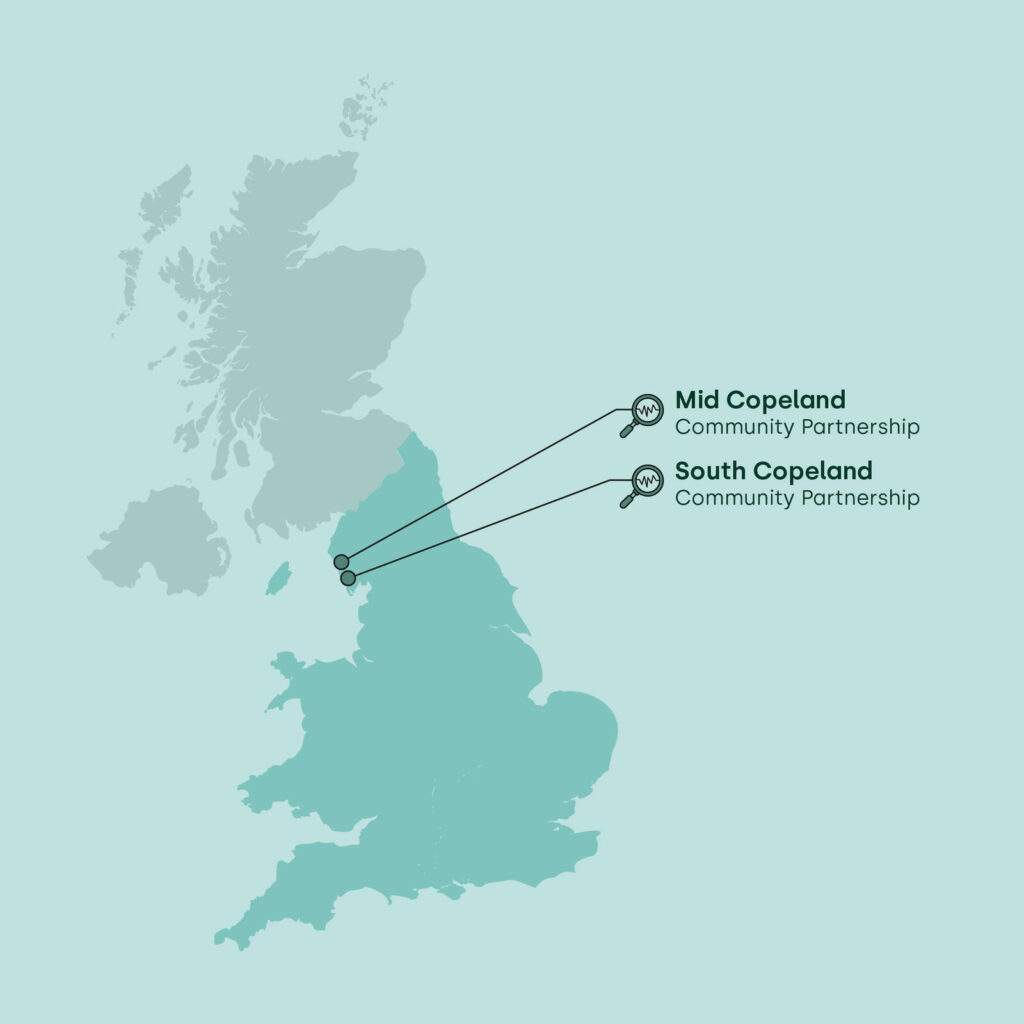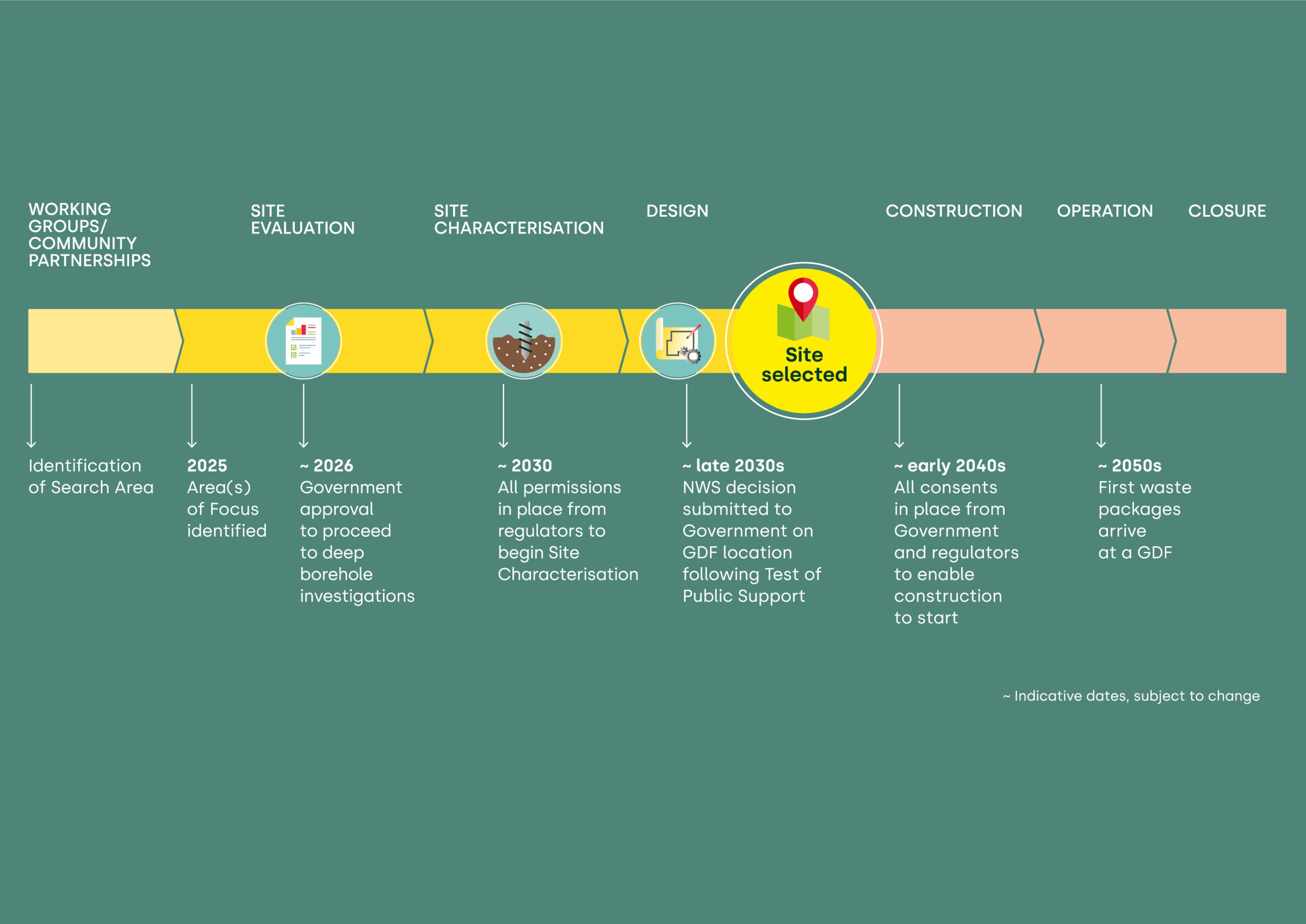Nuclear Waste Services (NWS) has investigated several locations in the UK for a potential site. Mid Copeland is one of two being considered.
- Mid Copeland
- South Copeland

Areas of Focus in detail
The NWS website has more information on Areas of focus in Mid Copeland here.
NWS held a series of events and webinars in early 2025 to talk with communities in more detail about Areas of Focus.
Common themes discussed at events included information about a suitable site and a willing community, Test of Public Support, Site Evaluation and Property Value Protection scheme.
Six factors are used to assess an area’s suitability for a GDF
Safety and security
If NWS cannot demonstrate that a site will be safe and secure during its construction and operation, the GDF will not be built. The geology must be suitable to support a safety case after it has been closed, and the facility must satisfy the UK’s strict safety and security standards.
Community
Through engagement, research and assessment, NWS will seek to ensure that the social and economic impact of a GDF will benefit the community.
Environment
The delivery of a GDF will represent one of the largest environmental protection projects in the UK. To successfully deliver a GDF, NWS will need to assess the impact on the natural and historic environment, protected habitats and species.
Engineering feasibility
The geology of an area will significantly influence whether and how a GDF can be designed, constructed and operated safely during its operation and closure. NWS will assess if the design, construction and operation of a GDF at a specific location is feasible.
Transport
To build and operate a GDF, NWS will need to be able to transport radioactive waste and construction materials safely and securely.
Value for money
A GDF will be built where it represents good value for money for the taxpayer over the long term.
What is involved in assessing a potential site?
1. Community engagement
NWS works in partnership with communities in an open and transparent way, with respect for a wide range of views. NWS will invite and welcome community engagement throughout the process but will not presume that this implies support for the development of a GDF.
2. Forming groups
A Working Group was formed in 2020 from Interested Parties, NWS, and a chair. The Working Group identified the geographical area where NWS would look for potentially suitable sites for a GDF. The Mid Copeland Community Partnership was formed in 2021.
3. Local activities
NWS will carry out Site Evaluation studies and works to develop site-specific designs and safety assessments for the surface and underground structures of a GDF. The Community Partnership’s engagement and activities also help NWS understand the local area.
4. Drilling boreholes
NWS would drill deep boreholes to determine a site’s suitability to host a Geological Disposal Facility. These boreholes would be drilled deeper than 150 metres below the surface. This process is called “Site Characterisation.”
The phases of decision-making

What is the timescale for the GDF programme?
2020
2025
SITE EVALUATION
Areas of focus identified (link follows)
~2026
Government approval to proceed to deep borehole investigations
~ 2030
SITE CHARACTERISATION
All permissions in place from regulators to begin Site Characterisation
Late 2030s
DESIGN
NWS decision submitted to Government on GDF location following Test of Public Support
SITE SELECTED
Early 2040s
CONSTRUCTION
All consents in place from Government and regulators to enable construction to start
~2050s
OPERATION
First waste packages arrive at a GDF
~ 2190
CLOSURE
~ indicative dates, subject to change.
The community decision-making process
The government’s policy on implementing geological disposal states the importance of community consent. This commitment is shown in a two-part process that gives communities control over their involvement.
The Right of Withdrawal – The relevant principal local authority on the Community Partnership has the right to withdraw from consideration at any point before the Test of Public Support. The GDF developer, Nuclear Waste Services, may also withdraw if technical assessments reveal the area is unsuitable for development.
The Test of Public Support – Before any construction begins, the community must demonstrate its willingness to host a GDF through a formal Test of Public Support. This is a crucial milestone in the process, determining whether the project can proceed. If the community decides against hosting the facility, the project cannot move forward in that location.
Involving the community
Local communities can share their views through:
- engagement activities
- community events
- direct communication with the Community Partnership
The Community Partnership is creating a vision for the future of the community and helps to provide answers to people’s questions.
